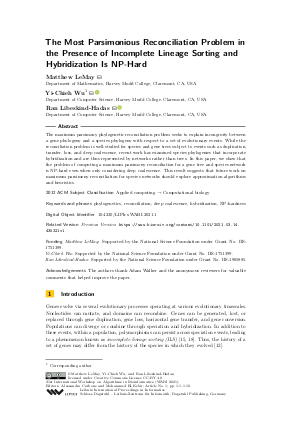@InProceedings{lemay_et_al:LIPIcs.WABI.2021.1,
author = {LeMay, Matthew and Wu, Yi-Chieh and Libeskind-Hadas, Ran},
title = {{The Most Parsimonious Reconciliation Problem in the Presence of Incomplete Lineage Sorting and Hybridization Is NP-Hard}},
booktitle = {21st International Workshop on Algorithms in Bioinformatics (WABI 2021)},
pages = {1:1--1:10},
series = {Leibniz International Proceedings in Informatics (LIPIcs)},
ISBN = {978-3-95977-200-6},
ISSN = {1868-8969},
year = {2021},
volume = {201},
editor = {Carbone, Alessandra and El-Kebir, Mohammed},
publisher = {Schloss Dagstuhl -- Leibniz-Zentrum f{\"u}r Informatik},
address = {Dagstuhl, Germany},
URL = {https://drops-dev.dagstuhl.de/entities/document/10.4230/LIPIcs.WABI.2021.1},
URN = {urn:nbn:de:0030-drops-143546},
doi = {10.4230/LIPIcs.WABI.2021.1},
annote = {Keywords: phylogenetics, reconciliation, deep coalescence, hybridization, NP-hardness}
}

 Creative Commons Attribution 4.0 International license
Creative Commons Attribution 4.0 International license
